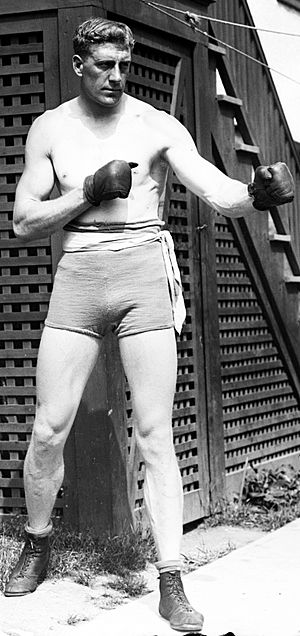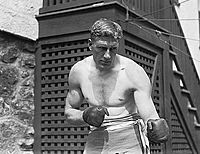Bombardier Billy Wells facts for kids
Quick facts for kids Bombardier Billy Wells |
|
|---|---|
 |
|
| Statistics | |
| Real name | William Thomas Wells |
| Nickname(s) | Bombardier |
| Rated at | Heavyweight |
| Height | 6 ft 3 in (1.91 m) |
| Nationality | British |
| Born | 31 August 1889 Stepney, London, England |
| Died | 12 June 1967 (aged 77) Ealing, London, England |
| Stance | Orthodox |
| Boxing record | |
| Total fights | 59 |
| Wins | 48 |
| Wins by KO | 30 |
| Losses | 11 |
William Thomas Wells, known to many as Bombardier Billy Wells, was a famous English heavyweight boxer. He was born on August 31, 1889, and passed away on June 12, 1967. Billy Wells held the titles of British and British Empire Champion from 1911 to 1919. He successfully defended his title an amazing fourteen times! In 1911, he made history as the first heavyweight boxer to win the Lonsdale Belt. This special belt was created in 1909 for British champions in all boxing weight classes.
Wells was quite tall for his time, standing at 6 feet 3 inches (1.91 meters). He weighed between 182 and 192 pounds (82.6 to 87.1 kg). He fought with an orthodox style, which means he was right-handed and led with his left foot and left jab.
Contents
Early Life and Army Days
Billy Wells was born in the East End of London, in a place called Stepney. He was the oldest of five brothers and one of nine children in his family. His dad, William Thomas Wells, was a musician, and his mom, Emily Rhoda Farrier, worked as a laundress. Billy went to Broad Street elementary school until he was about twelve. After that, he worked as a messenger boy. It was during this time that he started boxing as an amateur, just for fun and practice.
In 1906, when he was 17, Wells joined the Royal Artillery as a gunner. He was sent to a place called Rawalpindi (which is now in Pakistan). There, he boxed in championships for his army division and for all of India, winning many times. He was promoted to a higher rank called bombardier. This is where his famous nickname came from! He started training full-time with a special coach. It became clear that Billy was good enough to be a professional boxer. So, in 1910, he left the army and came back to Britain. This was a time when boxing was becoming super popular for people to watch.
Becoming a Professional Boxer
Billy Wells had his first professional boxing match on June 8, 1910. He fought against Gunner Joe Mills and won after six rounds. He won seven of his first eight fights! His ninth fight was for the British Heavyweight Title in London in April 1911. He fought against the champion, Iron (William) Hague. Wells won by knocking Hague out in the sixth round.
Later in 1911, Wells was supposed to fight the world heavyweight champion, Jack Johnson, in London. However, some people didn't like the idea of such a big prize money fight. Also, some people didn't want fights between boxers of different races. Because of this, the fight was stopped by Winston Churchill, who was a government official at the time. Sadly, this rule against different races fighting in British boxing lasted until 1947.
In December 1911, Wells fought Fred Storbeck for the British Empire Heavyweight Title. He won by knockout in the eleventh round, earning his second major title that year!
In June 1913, Wells faced a very skilled boxer from France named Georges Carpentier for the European Heavyweight Title. The fight was in Ghent, Belgium. Wells lost this fight by knockout in the fourth round. He defended his British heavyweight title three more times that year. Then, in December 1913, he had a rematch with Carpentier for the European title. This fight was in London, but Carpentier won again, this time by knockout in the very first round.
Billy Wells kept boxing and successfully defended his British heavyweight title, even after World War I began. In May 1915, he joined the military again, this time in the Welch Regiment, and became a sergeant. He continued to box until the end of 1916. In 1917, he was sent to France to help soldiers with their physical training.
After the war ended, Wells went back to boxing. His fourteenth defense of his British and British Empire titles was against Joe Beckett. Wells had beaten Beckett before. This fight happened in February 1919 in London. This time, Beckett won by knockout in the fifth round and took Wells' titles.
Wells had five more fights after that, winning all of them. Then, in May 1920, he had another rematch against Joe Beckett. This fight was in London, but Wells was knocked out again, this time in the third round. Billy Wells continued to fight eight more times, winning five and losing three. His very last fight was in April 1925.
After his boxing career, Wells became the third person to play the "gongman". This was the person seen hitting the big gong at the start of J. Arthur Rank movies.
Life Outside the Ring
In 1911, Billy Wells wrote a book called Modern Boxing: a Practical Guide to Present Day Methods. It shared his boxing knowledge.
On September 7, 1912, Wells married Ellen Kilroy. Her father owned a pub. Billy and Ellen had four children: Ellaline Beryl, William Thomas, Audrey Ellen, and Cynthia Diane. They later separated.
In 1923, he published another book, Physical energy: Showing how physical and mental energy may be developed by means of the practice of boxing.
The Lonsdale Belt that Wells won was very special. It was the original heavyweight belt and was made from real 22-carat gold! Later belts were not made of such pure gold. This belt was kept at the Royal Artillery Barracks in London for a long time. Now, it's at Larkhill, Salisbury, because the Royal Artillery moved their home.
Billy Wells lived in Ealing, London, and passed away there on June 11, 1967, at the age of 77. His ashes were placed in the crypt of St. Mary's parish church in Hanwell, west London.
Selected Filmography
- Kent, the Fighting Man (1916)
- The Silver Lining (1919)
- Beloved Imposter (1936)
- Make-Up (1937)
- We'll Smile Again (1942)
- Happidrome (1943)
See also
- List of British heavyweight boxing champions


